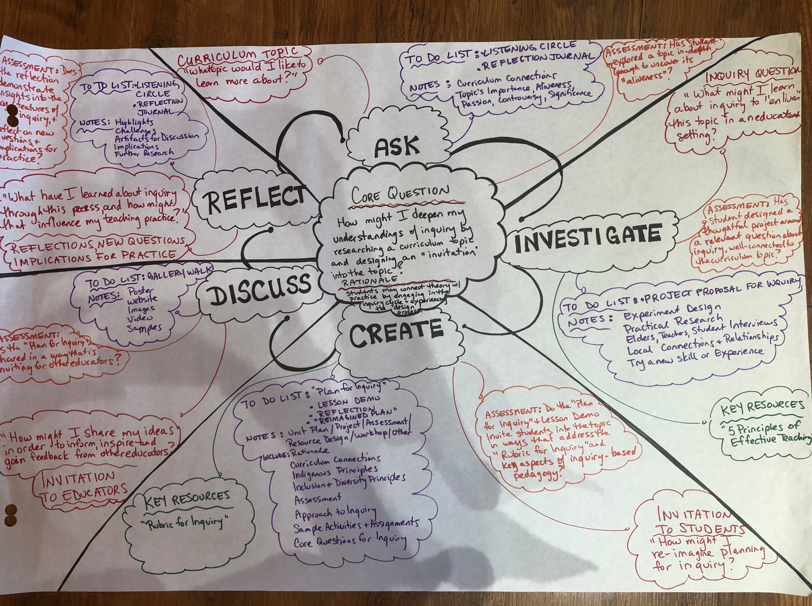This is your HOME PAGE, where you can write an introduction for yourself, and include some thoughts or images that invite your reader into your project.
This being a living inquiry, the best place to start it is wherever one finds oneself existentially. One looks inwardly into one’s own thoughts and feelings, while facing the world, noting how one reacts with conditioned thoughts and feeling responses. Usually we are too busy reacting that we do not stop to reflect and examine our response. Inquiry starts at this point of stop. From this place of stop, we question the necessity of “the way things are,” and address the possibility of seeing the world and the self differently and hence relating to the world differently. “What if I were to…?”
—Heesoon Bai, 2005, p. 47

Description: This assignment allows each student to experience the inquiry planning and implementation process. The purpose of this project is to “question the necessity of “the way things are,” [both in the way we teach in schools and in how we interpret the larger world] and address the possibility of seeing the world and the self differently, and hence relating to the world differently. We imagine otherwise possibilities when we ask, “What if I were to…?”” (Heesoon Bai, 2005, p. 47). The project will follow the Inquiry Cycle phases of Ask, Investigate, Create, Discuss and Reflect.
2 replies on “Welcome”
STAR: You used a discipline based inquiry approach effectively as you incorporated principals of thought, related that to building a character and then encouraged students to write their story. Based on this, students are clear about what it means to take a decision and how a character would feel while making a moral decision because they experienced these emotions themselves as they were presented with a dilemma. This will aid them in asking more questions as they build their character as they will be able to reflect on their personal experiences.
WISH: I do not know about the diversity in your classroom but I wonder if culture, religion and differences in values/perspectives would be worth discussing after presenting the moral dilemmas about decisions one would take on the train track. I think that students who come from faith-based households may feel uncomfortable discussing some of these scenarios because they are taught that killing is a sin/ prevents you from entering heaven/ . I wonder if they would feel comfortable thinking about the decision they would take without feeling guilty? Guilt is a powerful emotion that can have a major impact on them.
QUESTION/ INSPIRATION. In your reflection you made a comment that really inspired me. You wrote: “I wanted to let the student discussion become the content as opposed to having it become an accessory to the content.” WOW! For me this was ah-ha moment because teachers often intentionally/ unintentionally disregard what the students have to say and make their discussions an accessory. I think that this approach demotivates students to participate in the future as they may feel unheard. I think that by validating students’ concerns and discussions means taking an inquiry approach because you build on their knowledge by asking questions and allowing them to ask questions.
I have to say that despite you feeling like you went off track with time and some discussions while presenting in our group, I really appreciated you giving us the time to explore our thoughts and share our ideas with each other. I think that this is when learning/ realizations occurred that maybe would not have if you asked us to move on. So thank you! 🙂
Iliana
Hello Tyson,
I appreciate your interest introducing Moral philosophy through language arts, and other subjects of academical knowledge. I admire the way you illustrated how in “social studies class, the moral impacts of historical figures or modern social movements can be explored, Science classes could debate the merits of bioengineering or the impact of our actions on the environment, Math classes can discuss the implications of using data to drive decision-making and the potential devaluing of humans that may derive in these decisions, Art classes can discuss the ability of art to influence others and so on to deepen students’ views of morality as well as reflective writing to allow them to make connections to their own lives.” These days, subjects are studied or taught in relation to the real world to make those relevant, and negligible importance or time is devoted to make self-discoveries to realise one’s position, nature with respect to the outer world. Even in classes, important facts are ignored such as “everyone learns at its own pace depending upon abilities and interests”, personal growth is emphasised without considering individuality. Your approach would help learners to find their viewpoints, their definitions of good and bad to solve ethical dilemmas of daily lives in contrast to others’ definitions of these.
Undoubtedly, storytelling is the best way of communication, and I admire the effort to include indigenous knowledge of discovery through “Cree creation” and “oral storytelling”. Oral storytelling is great way to acknowledge diversity and accommodate those students who are not good with pen and paper to describe their emotions associated with their learning. Another aspect of this project that I loved is of the inculcation of “decision making” in students by presenting them examples of ethical dilemmas.
I hope you are considering the sensitivity of this topic, when you are opening ethical dilemmas in front of multicultural classroom, where students are from diverse backgrounds, with distinct worldviews, beliefs, and religions.
Thanking you for sharing interesting information about Moral Philosophy. 🙂
Rajmanpreet.